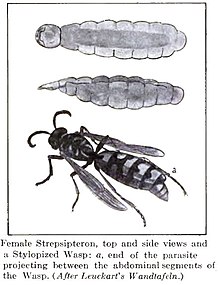Strepsiptera
| Strepsiptera Temporal range: 125–0 Ma Middle Cretaceous - recent |
|
|---|---|
 |
|
| male | |
 |
|
| Scientific classification | |
| Kingdom: | Animalia |
| Phylum: | Arthropoda |
| Class: | Insecta |
| Order: |
Strepsiptera Kirby, 1813 |
| Families | |
|
Bahiaxenidae |
|
Bahiaxenidae
Bohartillidae
Callipharixenidae
Corioxenidae
†Cretostylopidae
Elenchidae
Halictophagidae
†Mengeidae
Mengenillidae
Myrmecolacidae
†Protoxenidae
Stylopidae
The Strepsiptera (translation: "twisted wing"', giving rise to the insects' common name, twisted-wing parasites) are an endopterygote order of insects with nine extant families making up about 600 species. The early-stage larvae and the short-lived adult males are not sessile, but most of their lives are spent as endoparasites in other insects, such as bees, wasps, leafhoppers, silverfish, and cockroaches.
Males of the Strepsiptera have wings, legs, eyes, and antennae, and superficially look like flies, though their mouthparts cannot be used for feeding. Many of their mouthparts are modified into sensory structures. Adult males are very short-lived, usually surviving less than five hours, and do not feed. Females, in all families except the Mengenillidae, are not known to leave their hosts and are neotenic in form, lacking wings, legs, and eyes. Virgin females release a pheromone which the males use to locate them. In the Stylopidia, the female's anterior region protrudes out of the host body and the male mates by rupturing the female's brood canal opening, which lies between the head and prothorax. Sperm passes through the opening in a process termed hypodermic insemination. The offspring consume their mother from the inside in a process known as hemocelous viviparity. Each female thus produces many thousands of triungulin larvae that emerge from the brood opening on the head, which protrudes outside the host body. These larvae have legs (which lack a trochanter, the leg segment that forms the articulation between the basal coxa and the femur), and actively search out new hosts. Their hosts include members of the orders Zygentoma, Orthoptera, Blattodea, Mantodea, Heteroptera, Hymenoptera, and Diptera. In the strepsipteran family Myrmecolacidae, the males parasitize ants, while the females parasitize Orthoptera.
...
Wikipedia
